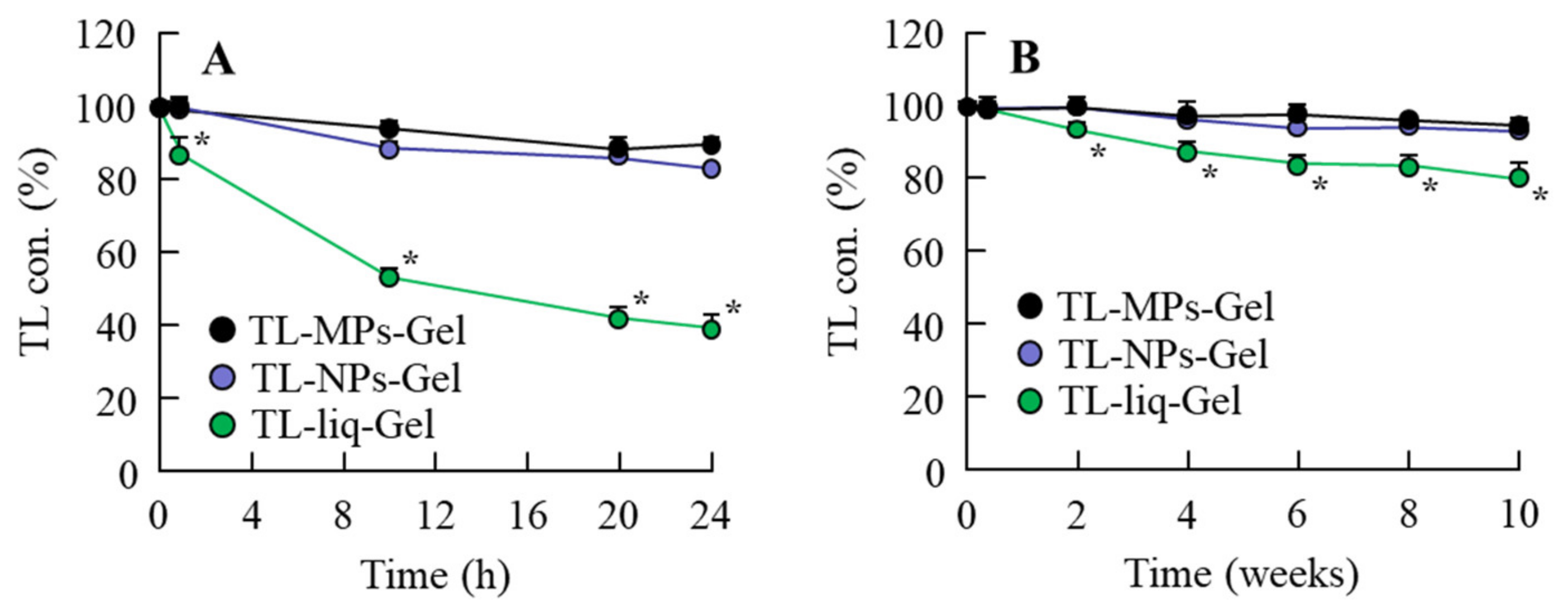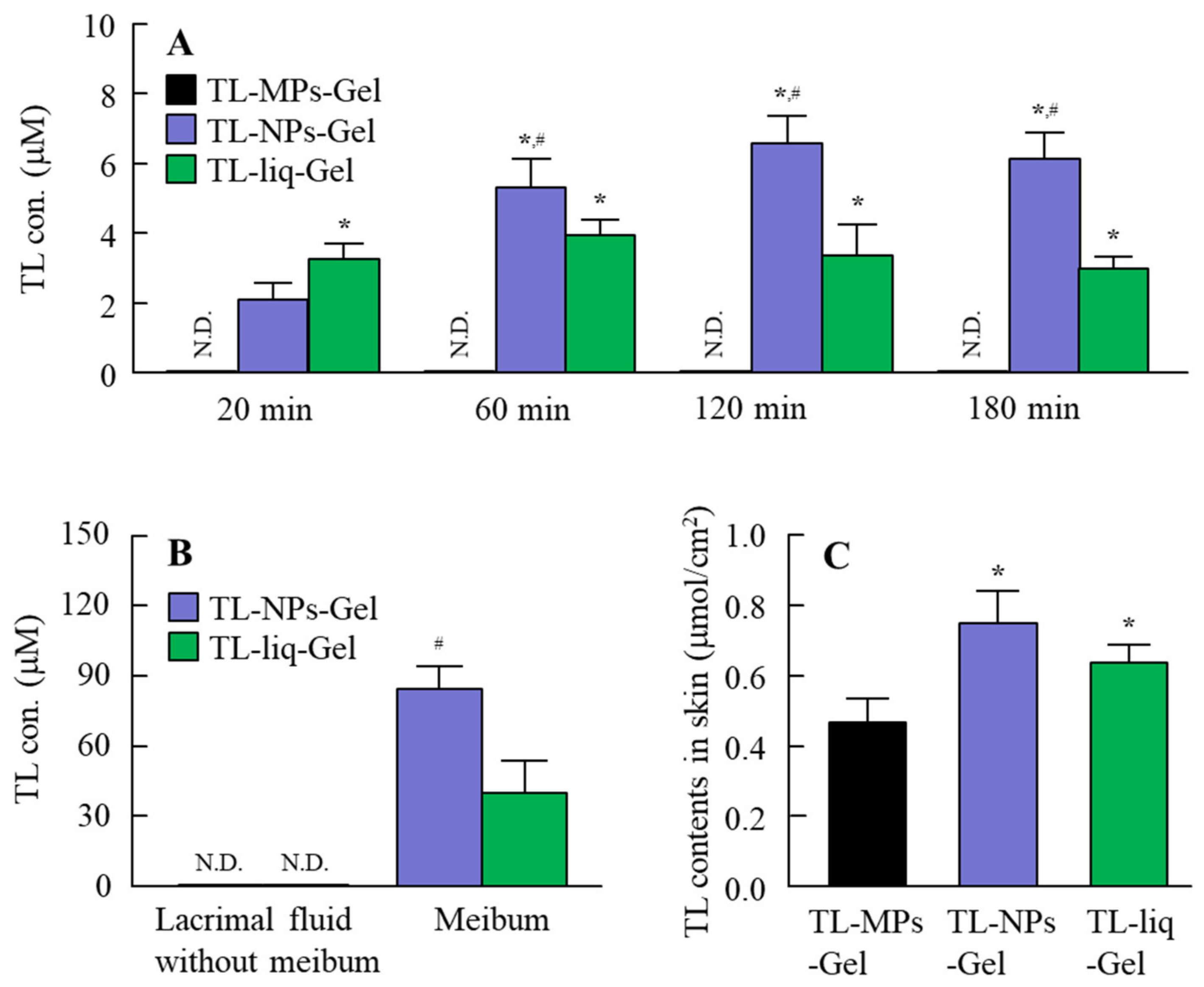Development of Sustained-Release Ophthalmic Formulation Based on Tranilast Solid Nanoparticles
Abstract
1. Introduction
2. Materials and Methods
2.1. Animals
2.2. Preparation of Ophthalmic Formulations Containing TL
2.3. Analysis of Crystal Form
2.4. Measurement of TL Levels
2.5. Measurement of TL Particles
2.6. Ratios of Solid TL and Liquid TL in Formulations
2.7. Photostability and Thermal Stability of TL Formulations
2.8. TL Release from TL Formulations
2.9. TL Content in Lacrimal Fluid and Meibum of Rabbits
2.10. Statistical Analysis
3. Results
3.1. Design of An Ophthalmic Formulation Based on TL Solid Nanoparticles
3.2. Sustained-Release of TL from TL-NPs-Gel
3.3. Sustained-Release DDS for TL-NPs-Gel through the Eyelid
4. Discussion
5. Conclusions
Author Contributions
Funding
Conflicts of Interest
References
- Baranowski, P.; Karolewicz, B.; Gajada, M.; Pluta, J. Ophthalmic Drug Dosage Forms: Characterisation and Research Methods. Sci. World J. 2014, 861904. [Google Scholar] [CrossRef] [PubMed]
- Gaudana, R.; Ananthula, H.K.; Parenky, A.; Mitra, A.K. Ocular drug delivery. AAPS J. 2010, 12, 348–360. [Google Scholar] [CrossRef] [PubMed]
- Gause, S.; Hsu, K.H.; Shafor, C.; Dixon, P.; Powell, K.C.; Chauhan, A. Mechanistic modelling of ophthalmic drug delivery to the anterior chamber by eye drops and contact lenses. Adv. Colloid Interface Sci. 2016, 233, 139–154. [Google Scholar] [CrossRef] [PubMed]
- See, G.L.; Sagesaka, A.; Sugasawa, S.; Todo, H.; Sugibayashi, K. Eyelid skin as a potential site for drug delivery to conjunctiva and ocular tissues. Int. J. Pharm. 2017, 533, 198–205. [Google Scholar] [CrossRef] [PubMed]
- Kimura, C.; Tojo, K. Development of a stick-type transdermal eyelid delivery system of ketotifen fumarate for ophthalmic diseases. Chem. Pharm. Bull. 2007, 55, 1002–1005. [Google Scholar] [CrossRef] [PubMed]
- Isowaki, A.; Ohtori, A.; Matsuo, Y.; Tojo, K. Drug delivery to the eye with a transdermal therapeutic system. Chem. Pharm. Bull. 2003, 26, 69–72. [Google Scholar] [CrossRef]
- Panus, P.C.; Campbell, J.; Kulkarni, S.B.; Herrick, R.T.; Ravis, W.R.; Banga, A.K. Transdermal iontophoretic delivery of ketoprofen through human cadaver skin and in humans. J. Control. Release 1997, 44, 113–121. [Google Scholar] [CrossRef]
- Hagigit, T.; Abdulrazik, M.; Orucov, F.; Valamanesh, F.; Hagedorn, M.; Lambert, G.; Behar-Cohen, F.; Benita, S. Topical and intravitreous administration of cationic nanoemulsions to deliver antisense oligonucleotides directed towards VEGF KDR receptors to the eye. J. Control. Release 2010, 145, 297–305. [Google Scholar] [CrossRef]
- Shen, J.; Wang, Y.; Ping, Q.; Xiao, Y.; Huang, X. Mucoadhesive effect of thiolated PEG stearate and its modified NLC for ocular drug delivery. J. Control. Release 2009, 137, 217–223. [Google Scholar] [CrossRef]
- Maestrelli, F.; González-Rodríguez, M.L.; Rabasco, A.M.; Mura, P. Preparation and characterisation of liposomes encapsulating ketoprofen-cyclodextrin complexes for transdermal drug delivery. Int. J. Pharm. 2005, 298, 55–67. [Google Scholar] [CrossRef]
- Sun, D.; Maeno, H.; Gujrati, M.; Schur, R.; Maeda, A.; Maeda, T.; Palczewski, K.; Lu, Z.R. Self-assembly of a multifunctional lipid with core-shell dendrimer DNA nanoparticles enhanced efficient gene delivery at low charge ratios into RPE cells. Macromol. Biosci. 2015, 15, 1663–1672. [Google Scholar] [CrossRef] [PubMed]
- Cagnie, B.; Vinck, E.; Rimbaut, S.; Vanderstraeten, G. Phonophoresis versus topical application of ketoprofen: Comparison between tissue and plasma levels. Phys. Ther. 2003, 83, 707–712. [Google Scholar] [CrossRef] [PubMed]
- Shinkai, N.; Korenaga, K.; Mizu, H. Yamauchi H. Intra-articular penetration of ketoprofen and analgesic effects after topical patch application in rats. J. Control. Release. 2008, 131, 107–112. [Google Scholar] [CrossRef] [PubMed]
- Katsumi, H.; Tanaka, Y.; Hitomi, K.; Liu, S.; Quan, Y.S.; Kamiyama, F.; Sakane, T.; Yamamoto, A. Efficient transdermal delivery of alendronate, a nitrogen-containing bisphosphonate, using tip-loaded self-dissolving microneedle arrays for the treatment of osteoporosis. Pharmaceutics 2017, 9, 29. [Google Scholar] [CrossRef]
- Nagai, N.; Ogata, F.; Otake, H.; Nakazawa, Y.; Kawasaki, N. Design of a transdermal formulation containing raloxifene nanoparticles for osteoporosis treatment. Int. J. Nanomedicine 2018, 13, 5215–5229. [Google Scholar] [CrossRef]
- Ebihara, T. Hada no seitou to rouka no mechanism. Healthist 2013, 218, 20–23. (In Japanese) [Google Scholar]
- Nagai, N.; Ogata, F.; Yamaguchi, M.; Fukuoka, Y.; Otake, H.; Nakazawa, Y.; Kawasaki, N. Combination with l-Menthol Enhances Transdermal Penetration of Indomethacin Solid Nanoparticles. Int. J. Mol. Sci. 2019, 20, 3644. [Google Scholar] [CrossRef]
- Nagai, N.; Ogata, F.; Ishii, M.; Fukuoka, Y.; Otake, H.; Nakazawa, Y.; Kawasaki, N. Involvement of Endocytosis in the Transdermal Penetration Mechanism of Ketoprofen Nanoparticles. Int. J. Mol. Sci. 2018, 19, 2138. [Google Scholar] [CrossRef]
- Nagai, N.; Iwamae, A.; Tanimoto, S.; Yoshioka, C.; Ito, Y. Pharmacokinetics and Antiinflammatory Effect of a Novel Gel System Containing Ketoprofen Solid Nanoparticles. Biol. Pharm. Bull. 2015, 38, 1918–1924. [Google Scholar] [CrossRef]
- Qi, W.; Chen, X.; Twigg, S.; Polhill, T.S.; Gilbert, R.E.; Pollock, C.A. Tranilast attenuates connective tissue growth factor-induced extracellular matrix accumulation in renal cells. Kidney Int. 2006, 69, 989–995. [Google Scholar] [CrossRef]
- Maita, E.; Sato, M.; Yamaki, K. Effect of tranilast on matrix metalloproteinase-1 secretion from human gingival fibroblasts in vitro. J. Periodontol. 2004, 75, 1054–1060. [Google Scholar] [CrossRef] [PubMed]
- Yasukawa, T.; Kimura, H.; Dong, J.; Tabata, Y.; Miyamoto, H.; Honda, Y.; Ogura, Y. Effect of tranilast on proliferation, collagen gel contraction, and transforming growth factor beta secretion of retinal pigment epithelial cells and fibroblasts. Ophthalmic Res. 2002, 34, 206–212. [Google Scholar] [CrossRef] [PubMed]
- Kondo, N.; Fukutomi, O.; Kameyama, T.; Orii, T. Inhibition of proliferative responses of lymphocytes to food antigens by an anti-allergic drug, N(30,40-dimethoxycinnamoyl) anthranilic acid (Tranilast) in children with atopic dermatitis. Clin. Exp. Allergy 1992, 22, 447–453. [Google Scholar] [CrossRef] [PubMed]
- Rogosnitzky, M.; Danks, R.; Kardash, E. Therapeutic potential of tranilast, an anti-allergy drug, in proliferative disorders. Anticancer Res. 2012, 32, 2471–2478. [Google Scholar] [PubMed]
- Itoh, F.; Komatsu, Y.; Taya, F.; Isaji, M.; Kojima, M.; Momose, Y.; Suzawa, H.; Miyata, H.; Shibazaki, T. Effect of tranilast ophthalmic solution on allergic conjunctivitis in guinea pigs. Nihon Yakurigaku Zasshi 1993, 101, 27–32. [Google Scholar] [CrossRef]
- Wang, M.; Zhang, J.J.; Jackson, T.L.; Sun, X.; Wu, W.; Marshall, J. Safety and efficacy of intracapsular tranilast microspheres in experimental posterior capsule opacification. J. Cataract Refract. Surg. 2007, 33, 2122–2128. [Google Scholar] [CrossRef]
- Isaji, M.; Kikuchi, S.; Miyata, H.; Ajisawa, Y.; Araki-Inazawa, K.; Tsukamoto, Y.; Amano, Y. Inhibitory effects of tranilast on the proliferation and functions of human pterygiumderived fibroblasts. Cornea 2000, 19, 364–368. [Google Scholar] [CrossRef]
- Song, J.S.; Jung, H.R.; Kim, H.M. Effects of topical tranilast on corneal haze after photorefractive keratectomy. J. Cataract Refract. Surg. 2005, 31, 1065–1073. [Google Scholar] [CrossRef]
- Furukawa, H.; Nakayasu, K.; Gotoh, T.; Watanabe, Y.; Takano, T.; Ishikawa, T.; Kanai, A. Effect of topical tranilast and corticosteroids on subepithelial haze after photorefractive keratectomy in rabbits. J. Refract. Surg. 1997, 13, S457–S458. [Google Scholar]
- Lee, M.J.; Jin, S.E.; Kim, C.K.; Choung, H.K.; Jeoung, J.W.; Kim, H.J.; Choe, G.; Hwang, J.M. Slow-releasing tranilast in polytetrafluoroethylene/polylactide-co-glycolide laminate delays adjustment after strabismus surgery in rabbit model. Investig. Ophthalmol. Vis. Sci. 2007, 48, 699–704. [Google Scholar] [CrossRef]
- Nagai, N.; Ono, H.; Hashino, M.; Ito, Y.; Okamoto, N.; Shimomura, Y. Improved corneal toxicity and permeability of tranilast by the preparation of ophthalmic formulations containing its nanoparticles. J. Oleo Sci. 2014, 63, 177–186. [Google Scholar] [CrossRef] [PubMed]
- Nagai, N.; Ito, Y. Therapeutic Effects of Gel Ointments containing Tranilast Nanoparticles on Paw Edema in Adjuvant-Induced Arthritis Rats. Biol. Pharm. Bull. 2014, 37, 96–104. [Google Scholar] [CrossRef] [PubMed]
- Nagai, N.; Ogata, F.; Otake, H.; Nakazawa, Y.; Kawasaki, N. Energy-dependent endocytosis is responsible for drug transcorneal penetration following the instillation of ophthalmic formulations containing indomethacin nanoparticles. Int. J. Nanomed. 2019, 14, 1213–1227. [Google Scholar] [CrossRef] [PubMed]
- Choi, J.Y.; Yoo, J.Y.; Kwak, H.S.; Kwak, B.U.; Nam, B.; Lee, J. Role of polymeric stabilizers for drug nanocrystal dispersions. Curr. Appl. Phys. 2005, 5, 472–474. [Google Scholar] [CrossRef]
- Kawabata, Y.; Yamamoto, K.; Debari, K.; Onoue, S.; Yamada, S. Novel crystalline solid dispersion of tranilast with high photostability and improved oral bioavailability. Eur. J. Pharm. Sci. 2010, 39, 256–262. [Google Scholar] [CrossRef] [PubMed]
- Mishima, S.; Maurice, D.M. The oily layer of the tear film and evaporation from the corneal surface. Exp. Eye Res. 1961, 1, 39–45. [Google Scholar] [CrossRef]
- Nagai, N.; Ishii, M.; Seiriki, R.; Ogata, F.; Otake, H.; Nakazawa, Y.; Okamoto, N.; Kanai, K.; Kawasaki, N. Novel Sustained-Release Drug Delivery System for Dry Eye Therapy by Rebamipide Nanoparticles. Pharmaceutics 2020, 12, 155. [Google Scholar] [CrossRef]






© 2020 by the authors. Licensee MDPI, Basel, Switzerland. This article is an open access article distributed under the terms and conditions of the Creative Commons Attribution (CC BY) license (http://creativecommons.org/licenses/by/4.0/).
Share and Cite
Minami, M.; Seiriki, R.; Otake, H.; Nakazawa, Y.; Kanai, K.; Tanino, T.; Nagai, N. Development of Sustained-Release Ophthalmic Formulation Based on Tranilast Solid Nanoparticles. Materials 2020, 13, 1675. https://doi.org/10.3390/ma13071675
Minami M, Seiriki R, Otake H, Nakazawa Y, Kanai K, Tanino T, Nagai N. Development of Sustained-Release Ophthalmic Formulation Based on Tranilast Solid Nanoparticles. Materials. 2020; 13(7):1675. https://doi.org/10.3390/ma13071675
Chicago/Turabian StyleMinami, Misa, Ryotaro Seiriki, Hiroko Otake, Yosuke Nakazawa, Kazutaka Kanai, Tadatoshi Tanino, and Noriaki Nagai. 2020. "Development of Sustained-Release Ophthalmic Formulation Based on Tranilast Solid Nanoparticles" Materials 13, no. 7: 1675. https://doi.org/10.3390/ma13071675
APA StyleMinami, M., Seiriki, R., Otake, H., Nakazawa, Y., Kanai, K., Tanino, T., & Nagai, N. (2020). Development of Sustained-Release Ophthalmic Formulation Based on Tranilast Solid Nanoparticles. Materials, 13(7), 1675. https://doi.org/10.3390/ma13071675





